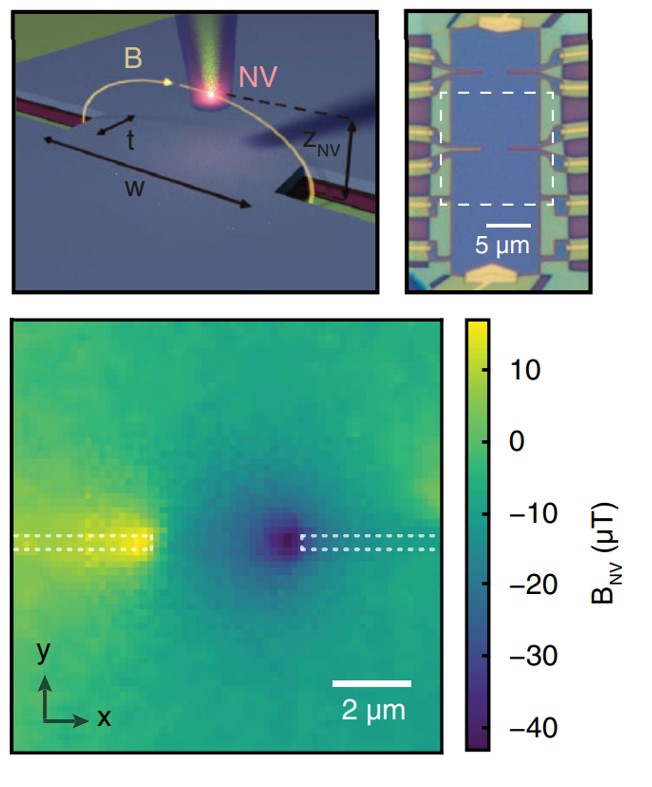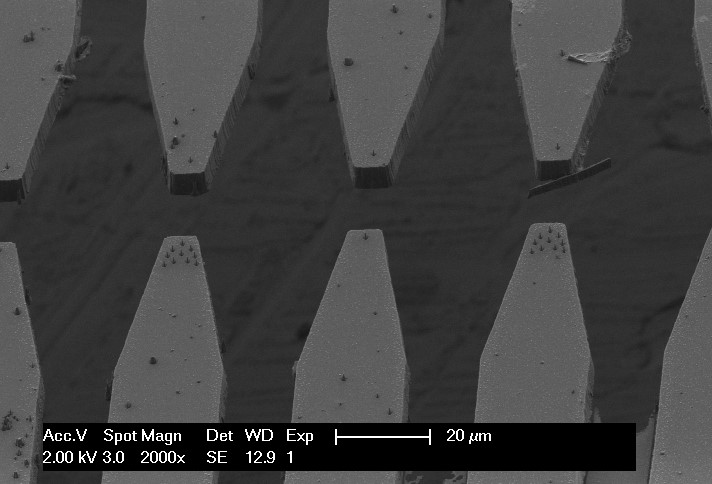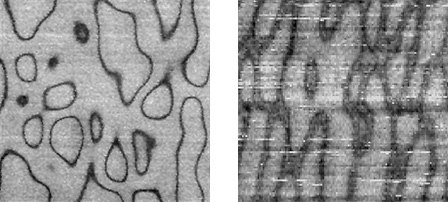



NV Center Based Scanning Magnetometer
We are developing a novel microscope based on single spins in diamond that promises nm-scale spatial resolution and sensitivity to single electron spins. Since the NV itself is an atomic quantum defect with excellent coherence and highly manipulable quantum states, we can employ a variety of measurements techniques to probe the physics of the condensed matter systems through our microscope. In addition to being a quantum sensor with excellent sensitivity and spatial resolution, NV centers are attractive magnetometers due to their minimal back action (the sensor itself is only a single spin!), simple optical readout, and operation over a wide range of temperatures, from room temperature down to liquid helium temperatures.
Our research program has two main objectives. The first is developing a diamond NV-based scanning probe magnetometer (NV-SPM). This includes the design and fabrication of our own diamond probes, which is a key ingredient of improving the stability, coherence, and readout fidelity of the NV center. We currently operate two such microscope systems and working to build a third one. The second thrust is using the NV-SPM to study various condensed matter systems. Some examples of the experiments we have done include imaging local conductivity in metals, superconducting vortices in high Tc superconductor, and electron flow in 2D material systems such as graphene.
DNA Origami Magnetometry
We are also working on a new platform that combines the strengths of shallow NV centers as quantum sensors and DNA origami as a breadboard for arranging molecules with spins into arrays. DNA origami is a technique that employs hundreds of short single-stranded DNA to fold a long single-stranded DNA into nanoscale architectures with designed 2D or 3D shapes. In collaboration with Professor Deborah Fygenson at UCSB, we design and synthesize such structures with arrays of single nitroxide spin labels or single Gadolinium spin labels. We then place the spin-labeled DNA origami onto the diamond surface. Our objective is to investigate these many-body spin systems via the dipolar interaction between the spin labels and shallow NV centers beneath the diamond surface.
Publications
Reporter-spin-assisted T1 relaxometry – arXiv 2208.11470 (2022).
Single-spin sensing of domain-wall structure and dynamics in a thin-film skyrmion host – Phys. Rev. Mater. 3, 083801 (2019)
Identifying and mitigating charge instabilities in shallow diamond nitrogen-vacancy centers – Phys. Rev. Lett. 122, 076101 (2019)
Optimizing the formation of depth-confined nitrogen vacancy center spin ensembles in diamond for quantum sensing – https://arxiv.org/abs/1901.11519
Nanoscale electrical conductivity imaging using anitrogen-vacancy center in diamond – Nature Comm. 9, 2406 (2018)
Room-Temperature Skyrmions in an Antiferromagnet-Based Heterostructure – Nano Lett. 18 (2), 980–986 (2018)
Scanned probe imaging of nanoscale magnetism at cryogenic temperatures with a single-spin quantum sensor – Nature Nanotechnology AOP (2016)
Two-dimensional nanoscale imaging of gadolinium spins via scanning probe relaxometry with a single spin in diamond – Phys. Rev. Applied 2, 054014 (2014)
Single-spin sensing of domain-wall structure and dynamics in a thin-film skyrmion host – Phys. Rev. Mater. 3, 083801 (2019)
Identifying and mitigating charge instabilities in shallow diamond nitrogen-vacancy centers – Phys. Rev. Lett. 122, 076101 (2019)
Optimizing the formation of depth-confined nitrogen vacancy center spin ensembles in diamond for quantum sensing – https://arxiv.org/abs/1901.11519
Nanoscale electrical conductivity imaging using anitrogen-vacancy center in diamond – Nature Comm. 9, 2406 (2018)
Room-Temperature Skyrmions in an Antiferromagnet-Based Heterostructure – Nano Lett. 18 (2), 980–986 (2018)
Scanned probe imaging of nanoscale magnetism at cryogenic temperatures with a single-spin quantum sensor – Nature Nanotechnology AOP (2016)
Two-dimensional nanoscale imaging of gadolinium spins via scanning probe relaxometry with a single spin in diamond – Phys. Rev. Applied 2, 054014 (2014)
